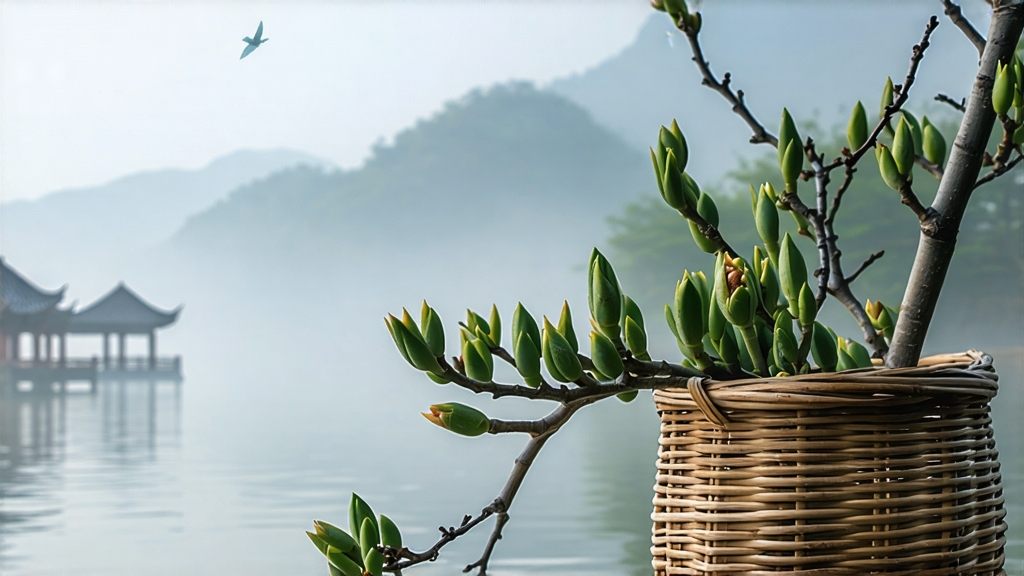
Among the jade-green pantheon of Chinese green teas, none carries the romance of lake mist and imperial whim quite like Biluochun. Its name—literally “Green Snail of Spring”—evokes the tight spiral of each leaf, a shape said to resemble the whorls of a tiny freshwater snail found along the shores of Taihu Lake. Yet behind the poetic name lies a 1,200-year story of monks, emperors, tea-smuggling poets, and the cool, mineral mists that rise where Jiangsu’s citrus groves meet the water’s edge.
Origin myths cluster around Dongting Mountain, actually two islands—East and West—anchored in the vast Taihu like floating gardens. During the late Tang dynasty, a nun named Lingji is credited with discovering wild tea trees whose leaves exuded an intoxicating perfume. She brewed them for traveling scholars, and word traveled up the Grand Canal to the imperial court. By the Kangxi era (1662-1722) the emperor, on a southern inspection tour, was served a tea so fragrant that he asked its name. Told it was “Xia Sha Ren Xiang” (“scary fragrance”), he deemed the moniker inelegant and rechristened it Biluochun, cementing its fame in the pantheon of China’s “Ten Famous Teas.”
Today the appellation is legally protected; only leaf picked on Dongting’s two islands and a narrow band of lakeside hills in Wuzhong District may bear the name. Within that micro-zone, three ecotypes are recognized: the original “wild” strain (xiao ye, small leaf), the heartier da ye (broad leaf) selected in the 1950s for higher yield, and the recently released “biluochun #5,” a clonal cultivar that keeps the classic curled shape while budding ten days earlier. Each thrives in the same yellow-brown loam laced with shell-rich sand blown in by prehistoric gales, soil that drains quickly yet holds just enough moisture for the shallow-rooted bushes.
The picking calendar is brutally short. Growers speak of “three golden days” around Qingming (early April) when the bud has not yet unfurled into a leaf and still carries the downy white tip that the locals call bai hao. Experienced pluckers use a scissor-like flick of thumb and forefinger to snap the bud plus the adjacent half-leaf, dropping the pick directly into a shallow bamboo sieves so the fragile down is never crushed. A master can harvest barely 500 g of fresh leaf in an hour; it takes 60,000 such buds—roughly a woman’s entire dawn-to-dusk yield—to finish one liang (50 g) of dry tea.
Withering is done outdoors for exactly 20 minutes on rush mats set in diffused sunlight. The goal is not dehydration but the first enzymatic nudge that coaxes grassy aldehydes toward the tea’s signature bouquet of apricot, narcissus, and fresh-cut alfalfa. When the leaf edges feel cool and velvety to the back of the hand, the batch is carried indoors for the true alchemy: pan-firing in a wok heated to 180 °C. The craftsman—almost always a woman, tradition says, for the gentler wrist action—keeps the leaf moving in a figure-eight for three minutes, then presses the mass against the iron wall for thirty seconds to set the curl. This kill-green step arrests oxidation yet preserves the soluble sugars that later translate into a sweet, soy-milk-like finish. Immediately afterward the same wok is cooled to 70 °C and the rolling phase begins: the leaves are cupped and rubbed against the metal in concentric circles, gradually tightening into the iconic spiral. Every 15 minutes the worker pauses to shake loose overheated fragments, a rhythm repeated six times over one hour. Finally the tea is dried in two passes—first at 60 °C to reach 20 % moisture, then at 50 °C until it squeaks when bitten. The entire transformation from fresh bud to finished snail takes less than four hours, a race against ambient humidity that could dull the bright jade color.
To unlock that color in the cup, water is the silent partner. The classical prescription is “Taihu water for Taihu tea,” drawn before sunrise when algae are still asleep and the calcium count dips below 40 ppm. Lacking a lake, any neutral spring water with 50–80 TDS performs well; distilled water